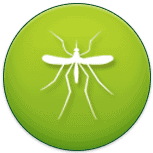A Clean and Tick Free Home is just a call away..
At Pointe Pest Control we take pride in protecting your home from year-round invaders and seasonal pests. Our experienced, licensed, and well-trained technicians are committed to providing your home with safe, environmentally friendly pest protection. We simply guarantee results, if pest activity persists after a service call, we will return for free until the problem has been solved.
Let’s Talk Terrible Ticks
Ticks 101
Often times, spiders and ticks are referred to or even believed to be insects, however, they are not part of the class Insecta. Rather, they belong to a separated class in the Arthropoda phylum called Arachnida. Arachnids have eight legs, simple eyes (instead of compound eyes), lack antennas and wings, and have segmented bodies broken down into two parts (unlike the three in insects).
Contrary to popular belief, ticks aren’t hiding in the woods waiting to jump on you as soon as you walk by. In fact, ticks cannot jump at all! As members of the arachnid family, ticks are expert climbers however and will use this skill to their advantage to find hosts. Climbing to the top branch of a bush, the end of a blade of grass, or the side of trees, the ticks will sit in rest, raising their front two limbs into the sky. These creepy, spindly arms have pads at the ends of them that are sticky and are meant for grabbing onto unsuspecting passersby. This tick practice is referred to by two names, “host seeking” and “questing,” and it is how ticks end up on your clothing, in your dog’s fur, or even in your hair.
Once there, their aim is to find a place to settle in and suck your blood. Unfortunately, these nasty parasites are notorious vessels of dastardly diseases and, since 2018 there has been a national increase in tick activity.
The Most Common Ticks in Illinois
While there are 15 species of ticks known to live in Illinois, the following 4 are the most common.
1. The American Dog Tick (Dermacentor variables)
American dog ticks are dark brown with an off-white dorsal shield pattern. This pattern on the females is shaped somewhat like a half moon facing their heads, while the males have more of a mottled pattern on their backs. American dog ticks are 5mm on average but can extend up to 15mm when engorged with a blood meal.
2. The Brown Dog Tick (Rhipicephalus sanguine)
Brown dog tick is found all throughout the United States and, unique to most other ticks, it has the ability to mature and live indoors. These ticks originate from tropical climates, making the harsh Illinois winters a death sentence for this species. However, due to their tendency to inhabit the indoors, they’ve managed to survive in a moderate population. Despite this, they are thankfully not known for carrying and transmitting human disease.
3. The Deer Tick/Blacklegged Tick (Ixodes scapularis)
Female blacklegged ticks (unsurprisingly) have dark black legs that stand out against their bright red-orange bodies, while the males are a darker brown/black. These ticks are infamous for transmitting Lyme disease as well as other pathogens such as Human Babesiosis and Human Granulocytic. They tend to prefer areas of higher elevation and inhabit thick, bushy areas where they have a high likelihood of encountering potential hosts. Blacklegged nymphs (the adolescent stage of ticks) are active during the spring and early summer while adults tend to be more active in the spring and fall.
4. The Lone Star Tick (Amblyomma americanum)
Lone star ticks are very prolific breeders and can deposit up to 5,000 eggs at a time. The females are also really easy to distinguish from other species of ticks due to the iconic white spot on their backs. They are generally larger than their male counterparts, but like the males, the rest of their bodies are reddish-brown with hints of yellow. Unfortunately, the Lone Star tick holds the record for most bites in the southcentral and southeastern United States. They are also known for carrying several different pathogens including Tularemia, Ehrlichiosis, Rickettsiosis, and even can cause Alpha-Gal Syndrome.
The Dangers of Ticks
No matter what stage of their life cycle that a tick is in, if it is infected with disease, it is able to spread the pathogens onto a new victim. Ticks are notorious vessels of disease and are well known for transmitting both Lyme disease and Rocky Mountain Spotted Fever. Tickborne diseases range from mild symptoms such as fever/chills, aches/pains, and rash, to severe medical emergencies that can require hospitalization. In some cases, when tickborne diseases are not attended to in a timely manner it can even cause lasting complications including, but not limited to, neurological damage and hearing loss.
Ticks and Pets
Unfortunately, ticks aren’t very picky eaters and will often target fluffy or fido for their next blood-meal. In the case that your little buddy does get stuck with one of these ectoparasites, you will want to remove it as soon as possible. Ticks can transmit diseases to pets just as they do to humans and, if a tick is left feeding undisturbed for long enough, your dog or cat may even be at risk of a condition called tick paralysis. In other serious cases, ticks can also pass a lethal infection to your furry friends called Cytauxzoonosis. Signs of this rapidly progressing and fatal infection include: high fever, loss of appetite, respiratory distress, jaundice, coma, and death. As such, it is incredibly important to monitor your pets for ticks whenever they may have come into contact with these dangerous pests, and take steps to remove them as soon as possible.
Staying Safe
Ticks are bad news and, according to the National Pest Management Association, there has been a national increase in tick activity over the last several years. So, staying safe from these pests is more important now than ever.
After being in any wooded areas or locations where ticks are known or suspected to inhabit, it is extremely important to conduct a tick check on both your family and your pets. Not only will this prevent ticks that were on your clothing and pet’s fur from getting into your yard, but it’s vital to help prevent those ticks from biting and attaching onto you. Try looking in any seams or folds of clothing, pockets, the belt region, any hats, and the lacing of your shoes. Be sure to also check under armpits and behind the knee.
But, the best way to stay safe, is to avoid ticks in the first place.
Top Tick Prevention
Scheduling routine Tick Control Treatments is the best way to protect yourself and your family from an onslaught of potentially dangerous bites from these arachnids. Our treatment includes elimination of ticks as well as warding off both mosquitos and fleas. Your exterminator will do a complete treatment of your yard to best safeguard your family and home from those pesky vectors of disease. Call us today for more information on how you can stay safe from these parasitic pests.
With Over 12,000 5 Star Reviews
Your Pest Problem is Gone, Guaranteed
Why Pointe Pest Control?
Pointe Pest Control is one of the largest family-owned and operated pest control companies in the U.S. We have pest control and customer service down to a science, and we know you’ll appreciate the results.
CALL (630) 581-2640
FOR YOUR FREE ESTIMATE TODAY







What We Will Cover
We simply guarantee results, if pest activity persists after a service call, we will return for free until the problem has been solved.
Pointe Pest Control Reviews
Here’s what our happy customers had to say about our services:
[wpbr_collection id=”5376″]
Request a Free Quote Today
(We do not share your data with anybody, and only use it for its intended purpose)








